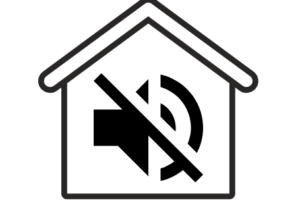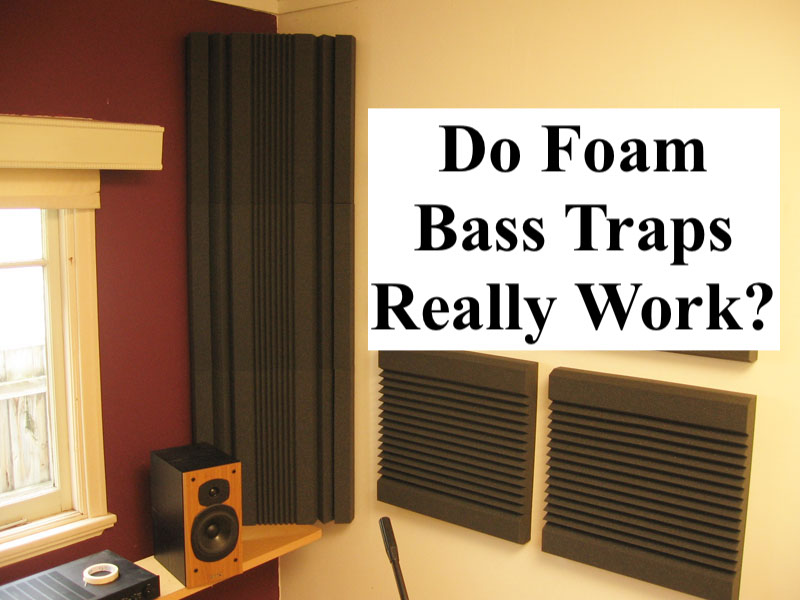Whether you’re trying to build a music room, a home theatre, or just generally looking at ways to you might improve your room’s acoustics, you would’ve come across foam bass traps for controlling low frequency sounds. There isn’t a lot of easily laid out information on the internet but here is what I found out:
Practically speaking, foam bass traps do provide a small difference to the acoustic environment. They cannot absorb truly bass frequencies that are lower than 100 Hz because they simply don’t have enough mass. There are a few alternatives to foam bass traps though, that do a better job of attenuating low frequencies. Let me explain:
Why Foam Bass Traps Don’t Really Trap Bass
Porous, acoustic foam bass traps work by absorbing the velocity of sound waves and converting it into heat through friction.
Keep in mind that this is NOT the same as blocking sound altogether, i.e soundproofing. Your flatmate will still hear you playing the drums as well as before, however, your room’s acoustics would’ve improved. That means lesser echoing.
While acoustic foam works considerably well to stop echoes- it does so because it is meant for mid to high frequencies only, which are easier to absorb.
Low frequency(or high wavelength) sounds travel longer distances and will persist in a room much, much more than other frequencies. THIS is what makes them tough to remove. You need a much thicker absorption material than plain acoustic foam.
What most manufacturers do is simply take the material that they used to manufacture acoustic panels, double the thickness and call it a Bass trap.
That simply isn’t good enough though.
This isn’t to say that there won’t be a noticeable difference- there will be a small difference for sure. Since bass traps are placed at the corners of a room where most low frequency buildup and echoes occur, they definitely provide an improvement than having nothing at all.
But will it be enough for you? Totally depends on how much improvement you’re happy with.
Check out this video below for an idea of how much improvement you can expect in the low frequencies:
What Are Bass Traps Made Out Of?
There basically are two types of bass traps:
- Porous bass traps
- Resonating bass traps
Let’s look at each of them separately
Porous Bass Traps
These tend to be smaller in size, and cheaper than resonating bass traps.
How do porous bass traps work?
These materials resist the flow of sound through their pores and stop it, to an extent, through friction.
A simple foam bass trap would, at most absorb frequencies till 100 Hz. If you still want better low frequency trapping, in the range of 50-100 Hz, you’ll need a mineral wool based porous trap, like this one.
Goes without saying, it’ll cost you a few hundred dollars more but it’s much, much better performance. You could also go for a fiberglass bass trap, but those are a bit more expensive and don’t really have any significant performance benefits over mineral wool.
What are porous bass traps made out of?
They’re typically made up of open cell foam, fibreglass or mineral wool and shaped like wedges in order to be placed at the 4 corners of the room.
The frame is usually either steel or fire resistant wood. Finally, a porous fabric, like the covering of a speaker grill is used for covering the entire thing.
Where to place porous bass traps?
Speaking from a position of practicality- you should place them at the corners.
It is preferable to get the wedge shaped bass traps rather than the flat panels because they have more depth, and hence more mass for the sound waves to travel through- which provides better absorption than just placing a flat panel acoustic foam at the corners.
This isn’t the most optimal placement for porous bass traps though.
The best positioning is a few feet away from the corners, diagonally. You should notice an immediate improvement in the bass trapping ability once you do this. This is because porous bass traps absorb sound velocity, which is at its maximum a few feet away from the corners of the walls.
To be more accurate, the velocity of a sound wave is maximum a quarter wavelength away from the wall- and it is nearly zero at the wall itself.
Which is why it’s better to place the porous absorber a little bit afar from the corners.
This isn’t a practical solution for most though, since you’ll need to place the traps at least 3 feet away to effectively counter ~100 Hz frequencies, and even farther off for lower frequencies.
Still, in case you have to improve the acoustics of a large room- remember this tip. Might just come in handy.
How many should you get?
Totally depends on your budget and how big your room is, but I’d say, get at least 4.
And if you can afford more- great- but if you only have 4, place them at the corners of the longest wall in the room- since that is where most low frequency resonance will take place.
If you still have some left over after covering up all the corners of the room, start stacking them up along the wall edges. If you do this completely, you should have a pretty solid acoustic environment!
Resonating Bass Traps
These are a bit bigger, high end solutions for bass trapping than foam traps. You’ll know you’re really serious about weeding out the bass sounds in your room if you’re thinking of buying these, because mostly only pro studios use these.
Resonating bass traps tackle a narrow range of frequencies, that too on the low frequency spectrum. And they do so very efficiently.
Foam bass traps, on the other hand, absorb a huge range of mid to high frequencies but aren’t very efficient.
There are two types of resonating bass traps:
- Diaphragmatic Bass Traps
- Helmholtz Resonators
How do resonating bass traps work?
Diaphragmatic bass traps are named because they work exactly like our diaphragm. Sound waves crash against the soft membrane or ‘diaphragm’ tied to a frame and the frame vibrates at the same frequency and hence, absorbs the bass.
Helmholtz Resonators consist of air tight cavities that have small ports for absorbing bass frequencies. These need to be tuned to target a specific bass frequency- they can only absorb the frequency they are tuned to resonate with.
The frequency you need to tune the resonator to will depend on your room’s geometry. You can read more about it here
How many resonating bass traps should you get?
Ideally you should get 4- one for each corner of the room. But given that that’ll put you back by ~1600-3000$ based on the average price of a few models that I looked up for this post, if you can’t afford that many, you should consult a professional before buying.
The reason I say that is that getting a resonating bass trap isn’t a one size fits all solution, especially a Helmholtz resonator- and depends on your room’s geometry.
Every room has different modes or pattern of sound waves’ motion and you’ll need to understand that first before getting an appropriate resonator trap that works for you.
Where to place resonator bass traps?
Unlike porous traps, the optimal position for placing the resonator bass traps is right at the corners of your room, next to a wall. This is because resonator bass traps absorb sound pressure, which is maximum at the corners of the room.
This can also be intuitively understood by the analogy of running head-first into a wall:
A little way from the wall, your velocity would be very high but as soon as you impact the wall, you stop, i.e: velocity goes down to zero.
However, the impact creates a pressure at the wall. THIS pressure is used by resonators to absorb the sound frequencies.
You can expect to easily counter frequencies in the range of 50-100 Hz with a resonator bass trap.
How To Make Cheap DIY Bass Traps
A lot of people on forums online have tried this and suggest you make your own bass traps instead of buying one.
In fact, you’ll probably end up with a better bass trap at a cheaper price if you make them correctly.
You’ll need some wood to build the frames, few panels of fibreglass and some breathable fabric. You’ll basically be making a box type construction that has 2 layers of fibreglass contained within a frame and covered by a layer of fabric.
If you’re more into DIY stuff, watch this youtube video to know how to make a really simple bass trap for about $40
Conclusion
Firstly, do remember that bass traps of any kind will NOT soundproof your room. They are an aid to improve your room acoustics.
Having said that, if you’re cash strapped, my suggestion would be to get some foam and fibreglass based porous bass traps. Get at least 2-4 for some noticeable results.
If you’re still looking for a better solution, consider getting a diaphragm resonator bass trap, which will counter the truly bass frequencies that a foam trap cannot get to.
It doesn’t need tuning and is easier to operate than a helmholtz resonator- which is the most expensive, as well as the most complicated to use.
Hope this post answered all your questions- do jump into the comments section below if it didn’t!


